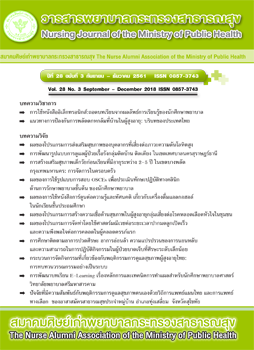Development of Wound Dressing E-Learning Lesson for Nursing Student in Srimahasarakham Nursing College
Main Article Content
Abstract
This research and development aimed to: 1) develop the wound dressing e-learning lesson for nursing student, 2) compare the learning achievement between pre test and post test of the student though e-learning lesson, and 3) to study the opinions towards wound dressing e-learning lesson. The samples were purposive sampling 46 second year bachelor nursing students who studied through e-learning lesson in Principles and Techniques in Nursing subject, first semester of 2017 academic year. The research instruments were e-learning lesson, the multiple choice achievement test, and an opinions questionnaire of development of e-learning on wound dressing. The data were analyzed by statistics such as frequency, percentage, mean, and standard deviation. Paired T-test was employed for testing mean difference at the .05 level of significance. The result of the study revealed that the efficiency of wound dressing e-learning lesson at 97.64 / 92.15 which was more than criteria set 80/80. The learning achievement post test was higher than pre test at the .05 level of significance. The opinions towards wound dressing e-learning lesson found that the overall were rate in high level. ( =3.69)
Article Details
บทความและรายงานวิจัยในวารสารพยาบาลกระทรวงสาธารณสุข เป็นความคิดเห็นของ ผู้เขียน มิใช่ของคณะผู้จัดทำ และมิใช่ความรับผิดชอบของสมาคมศิษย์เก่าพยาบาลกระทรวงสาธารณสุข ซึ่งสามารถนำไปอ้างอิงได้
References
2. Ministry of Digital Economy and Society. The 2017 household survey on the use of information and communication technology. Bangkok: National statistical office; 2018 [in Thai]
3. Roungrong P, Jirawongpong P, Manyam W, Somyarone W, Meundech S, Srisurat C. Educational technology VS Thai teacher in 21st century. Panyapiwat Journal. 2014;5(Special Issue):195-204. [in Thai]
4. Yang HH, Yuen SC. Handbook of research on practices and outcomes in e-learning: issues and trends. Hershey PA, USA: IGI global; 2009
5. Office of the National Economic and Social development Board. The 11th National Economic and Social development plan. Bangkok: The Prime Minister’s office; 2011 [in Thai]
6. Insard S. E-learning standard and learning object standard (internet). 2013 [cited 2013Dec 1] Available from: http://www.dretc.net/view.php?article_id=35. [in Thai]
7. Ghirardini B. E-learning methodologies A guide for designing and developing e-learning courses. FAO, Rome: Food and Agriculture Organization of the United Nations;2011
8. Wajanawisit T. Development of e-learning on information technology course, Kuakarun faculty of nursing. Kuakarun journal of nursing. 2014;21(1):100-12. [in Thai]
9. KosapanP. A development of e-learning data and information management. Journal of industrial technology Ubonratchathani Rajabhat University. 2014;4(1):61-6. [in Thai]
10. Baker W. Using e-learning to develop intercultural awareness in ELT: a critical evaluation in a Thai higher education setting. London, UK: British Council; 2012
11. Kaewprasert V. A study of analytical thinking and learning achievement via e-learning using case based learning method for undergraduate students of education program. Veridian E-Journal. 2014;7(2):947-61. [in Thai]
12. Lahti M, Hatonen H, Valimaki M. Impact of e-learning on nurses’ and student nurses knowledge, skills, and satisfaction: A systematic review and meta-analysis. International journal of nursing studies.2014;51(1):136–49.
13. Changa WY, Hsiao Sheenb ST, Changa PC, Leea PH. Developing an e-learning education program for staff nurses: Processes and outcomes. Nurse education today.2008;29(1):822-8.
14. Pintanasuwan C. Effects of e-learning by using inquiry based learning for creative problem solving of teaching profession students. Veridian e-journal.2014;7(2):238-50. [in Thai]
15. Veigh MH. Factors influencing the utilization of e-learning in post-registration nursing students. Nurse education today.2009;29(1):91–9.

